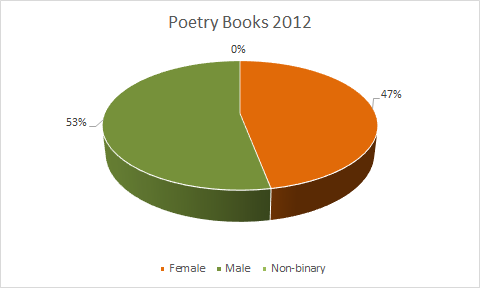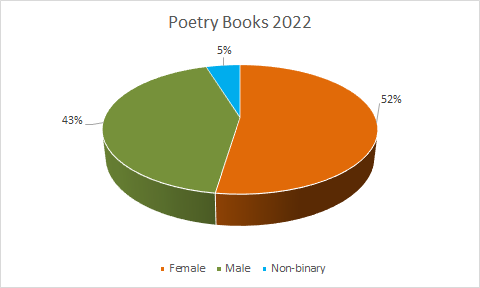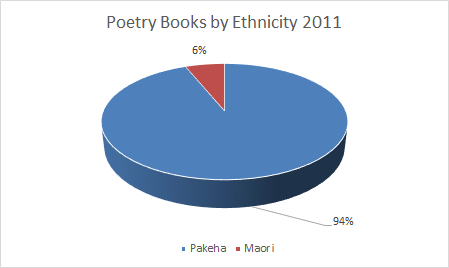Whose Poetry Gets Published in Aotearoa?
Yes, it’s time for more poetry pies!
Background
As a little side project, from time to time I analyse book titles published in Aotearoa New Zealand in any given year. I break the titles down by the gender and ethnicity of their authors. I do this because I’m curious to know how well the list of publications reflects our national population and because I like things to be fair.
Back when I started doing this in 2008, I was only looking at poetry titles by gender. Later, I started looking at ethnicity as well, and subsequently added fiction titles to the list. I publish the analysis on this blog with the hope that it might be useful.
Below is a comparison of poetry titles published in Aotearoa in 2011 and 2021 (the most recent information available in the Journal of Commonwealth Literature which I use as my data source).
I may get on to fiction later in the year. It takes a fair bit of time to plough through it all.
For the record, I’m Pākehā, born in the UK, and I’ve lived in Aotearoa since I was twelve. My pronouns are she/her.
Results :
Number of Titles
This is not great news. There were 65 poetry books published in 2011 compared with only 42 in 2021, a drop of 35%. Or to put it another way, only two-thirds as many poetry books were published in 2021 compared with ten years earlier. (I rely on the Journal of Commonwealth Literature for the list.) Thank goodness for the little presses who keep on putting poetry out there.
Gender
The ten years between 2011 and 2021 saw a switch in the gender balance from mainly men towards women and non-binary poets, although neither year saw a huge difference among genders.
In 2011, 57% of poetry titles published in New Zealand were written by men and 43% by women.
In 2021, 43% of poetry titles were by men, 52% by women and 5% by non-binary poets.


So the overall proportions are not hugely dissimilar, but I would hope that men continue writing poetry and continue getting published.
Ethnicity
The ethnicity of published poets was a sad story in 2011. Of poetry books published in 2011, 61 titles of 65 (94%) were by Pākehā authors, with the remaining 4 (6%) by Māori authors. No Asian, Pasifika or poets of other ethnicities were published in that year.
Things had got a whole lot better for Māori and Pasifika poets by 2021 with 4 titles each (10% of the total respectively) compared with 81% by Pākehā poets (percentages don’t add exactly due to rounding errors). No Asian poets or poets of other ethnicities were published that year.
While an improvement, this is still not reflective of the overall population. Māori were estimated to make up around 15% of the New Zealand population in 2018, Pasifika 7%, Pākehā 63%, Asian 14% and other ethnicites 1%
I’m aware that I’m only looking at poetry on the page and missing out zines, performance poetry and poetry in the digital space. Maybe it’s a whole different story across other media, but I like books I can hold in my hand.


Methodology
I have not conducted proper research. Someone should. This is a quick and dirty analysis of titles listed in the Journal of Commonwealth Literature, which lists an annual round-up of books published in Commonwealth countries in the previous year. It’s accessible online for a fee.
Then I try to find out how each author defines themselves in terms of gender and ethnicity. I usually look at three or more websites (eg author pages on publisher sites, Wikipedia, writers’ websites, the Academy of New Zealand Literature, the NZ Society of Authors). If someone mentions their pronouns or ethnic background, then great, I use that. Gender is usually fairly easy to find. If a poet is using female pronouns, I list them as female, etc.
Ethnicity can be trickier to find. If I’ve looked at several sites and there is no mention of ethnicity or iwi affiliation, I assume the author to be Pākehā. I may miss a few people this way. For books written by multiple authors with different genders and/or ethnicities (eg if a Pākehā man and an Asian woman co-authored a book), I list them as Other. If someone mentions they have a parent who is Māori, Pasifika or Asian, I add the person to the respective group. If someone has Māori and one or more other ancestries, I count them as Māori. It’s not perfect, but it does allow an analysis of trends over time.
If anyone finds errors, please let me know. I do my best, but this stuff is not peer reviewed.
Previous findings
Who Gets Published in Aotearoa? – the 2019 round-up
New Zealand Fiction & Non-Fiction by Gender & Ethnicity 2015
NZ Poetry 2015 by gender & ethnicity
NZ Fiction & Non-fiction by gender & ethnicity 2014
Poetry published in New Zealand, by gender & ethnicity – to 2014
Poetry & Gender in New Zealand Publishing – an occasional series
Poetry & Gender in New Zealand Publishing Part 2
Other Reading
Tina Makereti’s speech/essay Poutokomanawa – The Heartpost – Academy of New Zealand Literature (anzliterature.com)
Michalia Arathimos’ essay: The wharenui of New Zealand literature remains a gated community – E-Tangata
Tusiata Avia, Vaughan Rapatahana, Maria McMillan and Sarah Jane Barnett Why Can’t We All Just Get Along? The Literature Edition – Pantograph Punch (pantograph-punch.com)
Lani Wendt Young Lani Wendt Young on how the digital era is changing writing and reading for the better | RNZ



